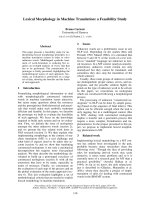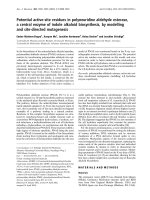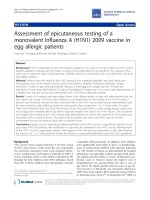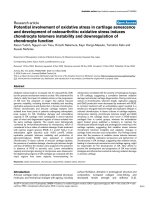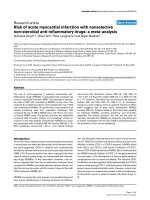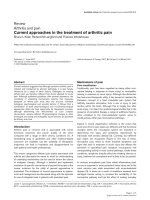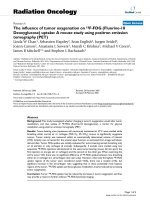Báo cáo y học: "Potential bias in testing for hyperprolactinemia and pituitary tumors in risperidone-treated patients: a claims-based study" pps
Bạn đang xem bản rút gọn của tài liệu. Xem và tải ngay bản đầy đủ của tài liệu tại đây (251.54 KB, 10 trang )
BioMed Central
Page 1 of 10
(page number not for citation purposes)
Annals of General Psychiatry
Open Access
Primary research
Potential bias in testing for hyperprolactinemia and pituitary
tumors in risperidone-treated patients: a claims-based study
Frank D Gianfrancesco*
1
, Gahan Pandina
2
, Ramy Mahmoud
3
,
Jasmanda Wu
4
and Ruey H Wang
1
Address:
1
HECON Associates Inc., 9833 Whetstone Drive, Montgomery Village, MD 20886, USA,
2
Johnson & Johnson Pharmaceutical Research
and Development, 1125 Trenton-Harbourton Road, Titusville, NJ 08560, USA,
3
Ethicon, Inc. (a Johnson & Johnson Company), PO Box 151,
Route 22 West, Somerville, NJ 08876-0151, USA and
4
Ortho-McNeil Janssen Scientific Affairs, LLC, 1125 Trenton-Harbourton Road, Titusville,
NJ 08560, USA
Email: Frank D Gianfrancesco* - ; Gahan Pandina - ;
Ramy Mahmoud - ; Jasmanda Wu - ; Ruey H Wang -
* Corresponding author
Abstract
Background: A reporting association of risperidone with pituitary tumors has been observed.
Because such tumors are highly prevalent, there may be other reasons why they were revealed in
association with risperidone treatment. We assessed two potential explanations:
disproportionately more prolactin assessment and head/brain imaging in risperidone-treated
patients vs patients treated with other antipsychotics.
Methods: Treatment episodes with risperidone, clozapine, olanzapine, quetiapine, ziprasidone,
aripiprazole, haloperidol, perphenazine and 'other typical' antipsychotics were identified in two
databases (large commercial, Medicaid). Comparisons used proportional hazards regression to
determine whether prolactin testing was disproportionate with risperidone, regardless of prior
potentially prolactin-related adverse events (PPAEs). Logistic regression determined whether
magnetic resonance imaging (MRI)/computed tomography (CT) were disproportionate in
risperidone-treated patients vs other patients, regardless of hyperprolactinemia or PPAEs. In each
regression, the 'other typical' antipsychotic category served as the comparator. Regression models
controlled for age, gender, and other factors.
Results: Altogether, 197,926 treatment episodes were analyzed (63,878 risperidone). Among
patients with or without preceding PPAEs, risperidone treatment was associated with a significantly
greater likelihood of prolactin assessment (hazard ratio (HR) 1.34, 95% confidence interval (CI) =
1.09 to 1.66, p = 0.007). Among patients with hyperprolactinemia or PPAEs, those treated with
risperidone (odds ratio (OR) 1.66, 95% CI 1.23 to 2.23, p = 0.001) or ziprasidone (OR 1.66, 95%
CI 1.06 to 2.62, p = 0.028) had a higher likelihood of MRI/CT.
Conclusion: Risperidone-treated patients are more likely to undergo prolactin assessment
regardless of prior PPAEs, and more likely to undergo MRI/CT in association with
hyperprolactinemia or PPAEs. Thus, a predisposition for more evaluations in risperidone-treated
patients may contribute to disproportionate identification and reporting of prevalent pituitary
adenoma.
Published: 11 February 2009
Annals of General Psychiatry 2009, 8:5 doi:10.1186/1744-859X-8-5
Received: 7 May 2008
Accepted: 11 February 2009
This article is available from: />© 2009 Gianfrancesco et al; licensee BioMed Central Ltd.
This is an Open Access article distributed under the terms of the Creative Commons Attribution License ( />),
which permits unrestricted use, distribution, and reproduction in any medium, provided the original work is properly cited.
Annals of General Psychiatry 2009, 8:5 />Page 2 of 10
(page number not for citation purposes)
Background
Hyperprolactinemia is a laboratory abnormality that may
result from clinical factors such as polycystic ovary dis-
ease, thoracic surgery or trauma, or pituitary tumor.
Hyperprolactinemia may also be induced by medications,
including antipsychotics [1]. The association between
antipsychotic medications and hyperprolactinemia has
been under investigation since at least the 1970s [2].
Because the release of prolactin from the pituitary gland is
inhibited by dopamine, any process resulting in a reduc-
tion in dopamine increases prolactin levels [3]. Therefore,
antipsychotics, which are believed to exert their therapeu-
tic effect by dopamine receptor blockade, cause prolactin
elevation due to loss of inhibition of pituitary lactotrophs
[4]. Conventional antipsychotics and the atypical antipsy-
chotic risperidone have been found to raise prolactin lev-
els [2,4-6]. In contrast, other atypical antipsychotics, such
as clozapine, quetiapine and olanzapine, have shown
smaller or transient effects on serum prolactin levels, pos-
sibly because their actions at other receptor sites result in
relatively less dopamine blockade [2,4-6], or because of a
lower peripheral to central distribution [7].
A 2006 pharmacovigilance study by Szarfman et al. found
spontaneous reporting of pituitary tumors to be dispro-
portionately higher among patients treated with risperi-
done compared with other antipsychotics. Based on
adjusted reporting ratios (that is, reports of specific
adverse events as a proportion of all reports of adverse
events for a given medication), reports of pituitary tumors
were 8-fold higher in risperidone-treated patients than in
olanzapine-treated patients, 31-fold higher than in
quetiapine-treated patients, 6-fold higher than in ziprasi-
done-treated patients, and 3-fold higher than in haloperi-
dol-treated patients. Szarfman et al. interpreted these
findings as suggesting that risperidone may have a causal
relationship with pituitary adenoma [8].
Whereas a potential link between risperidone and pitui-
tary tumor cannot be discounted, there may be other
explanations for the considerably higher number of
tumors reported with risperidone relative to other antip-
sychotics. Indeed, further examination of the putative link
between risperidone and pituitary tumor is warranted so
that clinicians may make informed decisions for their
patients, as it may not be practical or desirable to change
to another antipsychotic, particularly when the original
medication is effective.
Prolactin elevation is a definite concern of antipsychotic
treatment, and it is important that prolactin levels be
appropriately monitored. Consensus recommendations
propose that prolactin levels should be measured if signs
and symptoms, elicited through a careful and thorough
patient history, suggest hyperprolactinemia. If prolactin
levels are elevated in the presence of potentially prolactin-
related adverse events (PPAEs) the cause of hyperprol-
actinemia should be determined, and consideration
should be given to changing to a prolactin-sparing antip-
sychotic [9]. However, clinicians may test prolactin levels
routinely in patients who take antipsychotics known to
increase prolactin, even in the absence of PPAEs.
Disproportionate prolactin testing in risperidone-treated
patients can ultimately lead to the identification of pitui-
tary tumors that would otherwise remain undetected,
because such tumors are usually small, benign, and endo-
crinologically silent [10]. In fact, they generally are discov-
ered only incidentally via brain imaging studies or upon
autopsy. A recent meta-analysis found the estimated prev-
alence of asymptomatic pituitary tumors in the general
population to be quite high: 14.4% in autopsy studies and
22.5% in radiological studies [11]. Given that they are
quite common, but usually asymptomatic, pituitary
lesions found in patients receiving risperidone may be
misinterpreted as having an etiologic relationship with
the treatment drug.
Szarfman et al. used a pharmacovigilance database to
examine cases of pituitary tumor. The frequency of diag-
nosed pituitary tumors can also be determined from
claims data. However, claims data may be subject to cer-
tain biases. Not all adverse events require or receive med-
ical attention, and the proportion of events that is actually
diagnosed may vary across medications. Further, two
forms of potential bias may occur in association with ris-
peridone treatment: (1) patients may be more likely to
undergo testing for prolactin elevation, regardless of the
prior presence of PPAEs, leading to a diagnosis of hyper-
prolactinemia that otherwise may have remained clini-
cally silent; and (2) risperidone-treated patients,
particularly those with PPAEs, may be more likely to
undergo investigation that could result in an incidental
diagnosis of benign pituitary tumors. Both sources of bias
would contribute to a higher frequency of diagnosed pitu-
itary tumors, the first by expanding the patient base and
the second, directly. In this context, using claims data, we
examined whether there was potential bias in the report-
ing of pituitary tumors among patients treated with risp-
eridone. Given the relatively high frequency of
asymptomatic pituitary tumors in the general population,
the effect of these potential biases on the rate of diagnosed
pituitary tumors would be potentially large.
Methods
This study was based on merged claims data from 135,472
patients with either commercial insurance or on public
assistance covering the period from 1999 to March 2003
(public assistance) and August 2003 (commercial). Com-
mercial claims were drawn from the PharMetrics patient-
Annals of General Psychiatry 2009, 8:5 />Page 3 of 10
(page number not for citation purposes)
centric database and public assistance claims were from
the Ohio Medicaid program. All patients with a mental
disorder (as per International Classification of Diseases,
Ninth Revision, Clinical Modification (ICD-9-CM) codes
290.xx to 316.xx) with at least two sequential prescrip-
tions for the same antipsychotic were included. Compari-
sons were made among risperidone, clozapine,
olanzapine, quetiapine, ziprasidone, haloperidol, per-
phenazine (each coded individually), and all other typical
antipsychotics grouped into a single category. Among the
typicals, haloperidol and perphenazine were given indi-
vidual attention because of their prominence in clinical
and other prospective trials.
The sampling unit, which served as the basis for determin-
ing frequencies of pituitary tumor, hyperprolactinemia
and other related conditions, and diagnostic tests, was the
antipsychotic treatment episode (exposure interval) rather
than the patient. An antipsychotic treatment episode was
defined as a sequence of two or more prescriptions for a
specific antipsychotic agent (a subsequent prescription
provides reasonable assurance that the first prescription
was used). Episodes were measured from the date of the
first prescription for an antipsychotic to the final date of
treatment with that antipsychotic. The final date was cal-
culated from the date of the last prescription available in
the database, plus the number of days for which it was
supplied, unless preceded by patient disenrollment from
the health plan or the end of the data period, in which
case the episode was censored. The first prescription in an
episode was based on a prior gap in prescriptions for the
defining antipsychotic in excess of 90 days. Gaps of less
than 90 days within treatment episodes were allowed.
Gaps rarely exceeded 90 days without complete discontin-
uation of a medication. Some patients had multiple treat-
ment episodes with the same or a different antipsychotic.
Additionally, treatment episodes with different antipsy-
chotics overlapped in many cases; thus, a given period for
a patient could be characterized by two concurrent expo-
sures. The real-world practice of switching antipsychotics
or discontinuing antipsychotic treatment renders use of
the patient as the sampling unit inaccurate for associating
antipsychotic side effects. Such a treatment episode
approach has been used in other published studies
[12,13].
To be included, treatment episodes also had to be associ-
ated with a prior patient history of at least 180 days. This
prior patient history was used to assess prior antipsychotic
treatment and pre-existence of pituitary tumor, hyperpro-
lactinemia and PPAEs (ICD-9 diagnostic codes for gyne-
comastia, galactorrhea, oligomenorrhea, amenorrhea,
dysmenorrhea, hypogonadism, hypothyroidism, infertil-
ity-male-hypospermatogenesis, infertility-female-pitui-
tary/hypothalamic, impotence-organic, psychosexual
dysfunction, genitourinary malfunctions arising from
mental factors, and alopecia). Treatment episodes show-
ing pre-existence of any of these prior to the start of treat-
ment with a specific antipsychotic were excluded.
The study focused on the frequency of prolactin tests,
head/brain diagnostic procedures, and pituitary tumors
diagnosed after the start of each antipsychotic treatment.
To avoid false associations, measurement was confined to
the treatment episode plus 30 days beyond (unless the
episode was censored). This 30-day extension allowed for
the inclusion of diagnoses and tests that were triggered by
the same circumstances that caused termination of the
antipsychotic.
Investigation bias
Antipsychotics were compared with respect to the likeli-
hood of a patient receiving a prolactin test. Using propor-
tional hazard regression, hazard ratios (HR) were
estimated for clozapine, risperidone, olanzapine, quetiap-
ine, ziprasidone, haloperidol, and perphenazine vs all
other typical antipsychotics as a single category. The
model included factors for type of antipsychotic treat-
ment, prior presence of potentially prolactin-related
symptoms (as described above), patient age, gender, con-
current use of antipsychotics, mental disorder diagnoses,
and type of insurance. After controlling for the prior pres-
ence of symptoms, in the absence of bias, one would not
expect to observe any association between the type of
antipsychotic treatment and the likelihood of receiving a
prolactin test. A significant positive association would
reflect a disproportionate tendency to test, irrespective of
symptom presentation.
The likelihood of receiving a head/brain magnetic reso-
nance imaging (MRI) or computed tomography (CT) scan
was compared among antipsychotic categories. Using
logistic regression, odds ratios (ORs) were estimated for
clozapine, risperidone, olanzapine, quetiapine, ziprasi-
done, haloperidol, and perphenazine vs all other typical
antipsychotics as a single category. The model included
factors for patient age, gender, duration of antipsychotic
treatment, presence of hyperprolactinemia or a closely-
related condition (gynecomastia, galactorrhea, oligomen-
orrhea, amenorrhea, and dysmenorrhea), presence of
other conditions requiring head/brain imaging studies
(skull or brain injury 6 months before or during treat-
ment, skull or brain neoplasm 6 months before or during
treatment), concurrent use of antipsychotics, mental dis-
order diagnoses, type of insurance, and censoring.
A significant interaction between the indicator for hyper-
prolactinemia or closely-related symptoms and the antip-
sychotic categories would capture bias in the propensity to
screen for pituitary tumors when hyperprolactinemia was
Annals of General Psychiatry 2009, 8:5 />Page 4 of 10
(page number not for citation purposes)
present. That is, the interaction tests whether hyperprol-
actinemia is differentially associated with a diagnostic
investigation, depending on the antipsychotic category or,
alternatively, whether the association between the diag-
nostic investigation and antipsychotic category depends
on the presence or absence of hyperprolactinemia. Inde-
pendent associations between the antipsychotics and the
use of head/brain imaging studies are of less interest; sim-
ply being treated with a particular antipsychotic would
not seem sufficient for differential testing for pituitary
tumor.
Reporting bias
Relative frequencies (percentages of treatment episodes)
of newly-diagnosed pituitary tumors (as described above)
were compared among the antipsychotic categories using
ICD-9 coding categories of benign, uncertain, unspecified,
and malignant. Because treatment duration (exposure
time) varied considerably among the antipsychotic cate-
gories, relative frequencies were standardized against a 1-
year exposure to adjust for variable treatment episode
durations.
Results
A total of 135,472 patients were identified, receiving a
total of 197,926 treatment episodes (exposure intervals)
with an antipsychotic medication. The overwhelming
majority of these patients had mental disorder diagnoses
(ICD-9-CM) of schizophrenia, bipolar disorder, major
depression, or dementia. A total of 40,651 patients had
multiple treatment episodes (17,235 with the same antip-
sychotic and 23,416 with a different antipsychotic), aver-
aging 2.54 episodes per patient. The antipsychotics did
not differ appreciably with respect to the proportion of
patients with multiple episodes. Overall, there were
69,873 episodes with risperidone, 2,093 with clozapine,
56,138 with olanzapine, 36,857 with quetiapine, 7,183
with ziprasidone, 10,743 with haloperidol, 2,956 with
perphenazine, and 18,132 with all other typical antipsy-
chotics. There was at least some concurrent use (mostly
representing the transition from one antipsychotic to
another) in 72,038 of the total 197,926 treatment epi-
sodes.
Patient characteristics are summarized in Table 1. Average
treatment durations were similar across drugs, except for
clozapine and ziprasidone. The longer duration and many
other differences were expected in association with cloza-
pine treatment based on its different indicated population
(treatment-refractory patients who have failed other
options), the requirement for monitoring due to risk of
agranulocytosis, use in different settings of care, small
exposed population, and other factors. The shorter aver-
age treatment duration for ziprasidone was anticipated as
a result of its later entry into the market relative to other
antipsychotics. Patients treated with typical antipsychotics
were generally older than those treated with atypical
agents, with ziprasidone-treated patients being the young-
est. Gender proportions varied considerably; clozapine
was the only agent used in more males than females. Con-
current use of other antipsychotics, particularly other
atypical antipsychotics, was relatively low for both risperi-
done-treated and olanzapine-treated patients.
The majority of patients (55% to 75%, depending on
antipsychotic) were covered by Medicaid. Among pri-
vately insured patients, a health maintenance organiza-
tion (HMO) was generally the most prevalent form of
coverage, with preferred provider, point-of-service, and
other types making up the remainder.
Although a higher proportion of risperidone-treated
patients received a diagnosis of hyperprolactinemia after
the start of treatment, the proportion of patients with
PPAEs was similar among the antipsychotics even after
differences in treatment duration were taken into account.
Consistent with the more frequent diagnosis of hyperpro-
lactinemia was the more frequent prolactin testing among
risperidone-treated patients. The frequency of prolactin
tests in risperidone-treated patients was about two times
that in patients treated with olanzapine, haloperidol, or
perphenazine and about 50% higher than that in patients
treated with quetiapine.
Proportional hazards regression results for prolactin tests
are reported in Table 2. Among the antipsychotics, risperi-
done alone was associated with a significantly greater like-
lihood (HR 1.34, p = 0.007) of prolactin testing compared
with the reference group, after controlling for prior pres-
ence of potentially prolactin-related symptoms and other
patient characteristics. The estimated HR suggests that the
likelihood of testing with risperidone was nearly 35%
higher than the 'all other typicals' category. Although not
statistically significant, estimated HRs for clozapine, olan-
zapine, quetiapine, haloperidol and perphenazine were
all less than 1.0. Prior claims for prolactin-related symp-
toms, as would be expected, had a large significant effect
on the likelihood of prolactin testing (HR 6.74, p <
0.0001). The interaction of risperidone with this variable
was also positive and significant (HR 1.41, p = 0.0269),
suggesting a 41% greater likelihood of prolactin testing
among risperidone-treated patients with PPAEs compared
with similarly symptomatic patients treated with 'other
typicals'. Interaction terms for the other antipsychotics
were not statistically significant.
Among the other variables in the model, increasing
patient age and male gender showed significant decreased
associations with the likelihood of prolactin testing. Con-
current use of atypical antipsychotics, diagnoses of affec-
Annals of General Psychiatry 2009, 8:5 />Page 5 of 10
(page number not for citation purposes)
Table 1: Patient characteristics by antipsychotic category
Clozapine Risperidone Olanzapine Quetiapine Ziprasidone Haloperidol Perphenazine Other typicals
Number of treatment episodes 2,039 63,878 56,138 36,857 7,183 10,743 2,956 18,132
Duration of treatment, mean (SD), mo 16.0 (13.8) 10.5 (9.9) 9.9 (9.8) 9.7 (8.9) 7.1 (5.5) 9.8 (9.9) 10.2 (9.7) 9.5 (9.4)
Age, mean (SD), years 45 (16) 44 (25) 46 (21) 41 (20) 36 (16) 53 (21) 52 (19) 50 (18)
Males, % 54.4 46.3 45.3 39.4 41.8 46.5 36.7 40.2
With diagnosis of hyperprolactinemia during treatment, % 0.25 0.44 0.09 0.17 0.25 0.18 0.27 0.25
With prolactin test during treatment, % 1.52 2.06 1.15 1.41 1.84 0.94 1.05 1.08
With potentially prolactin-related symptoms during
treatment, %*
9.1 7.1 6.5 7.9 7.9 6.0 7.1 7.0
With head/brain MRI or CT scan during treatment, % 16.8 12.1 11.4 11.9 8.5 13.8 11.6 13.7
With skull/brain injury or neoplasm 6 months prior to or
during treatment, %†
4.17 3.94 4.11 3.87 2.28 8.02 2.64 6.48
With diagnosis of non-malignant pituitary tumor during
treatment, %
Benign 0.15 0.13 0.05 0.06 0.11 0.08 0.03 0.07
Uncertain behavior 0.00 0.04 0.01 0.00 0.06 0.00 0.00 0.04
Unspecified 0.05 0.07 0.06 0.05 0.01 0.05 0.00 0.10
Malignant 0.05 0.03 0.01 0.01 0.00 0.02 0.00 0.03
Used another antipsychotic within 6 months prior to
treatment, %
71.8 30.2 37.0 50.7 74.7 54.0 46.9 71.8
Concurrent use of other atypical antipsychotic, ratio of days
supply to index antipsychotic days supply, mean (SD)
0.32 (0.41) 0.09 (0.25) 0.10 (0.25) 0.16 (0.32) 0.27 (0.39) 0.43 (0.45) 0.30 (0.42) 0.27 (0.40)
Concurrent use of other typical antipsychotic, ratio of days
supply to index antipsychotic days supply, mean (SD)
0.16 (0.32) 0.05 (0.18) 0.07 (0.22) 0.07 (0.23) 0.08 (0.23) 0.04 (0.17) 0.05 (0.19) 0.07 (0.22)
Diagnoses, %:
Schizophrenia 84.4 24.9 30.3 27.5 42.5 52.2 38.3 38.4
Affective psychoses 46.2 50.7 57.1 63.4 64.1 39.0 52.4 40.2
Other psychoses 43.3 37.2 34.2 30.1 26.7 49.8 38.5 28.9
Other non-psychotic mental disorders 66.8 69.3 69.1 74.2 70.1 61.2 61.5 62.4
Health coverage:
Medicaid 75.6 64.0 62.4 62.5 55.4 75.0 71.9 73.6
HMO 12.5 20.9 19.8 18.0 20.5 15.4 14.7 14.3
Other health coverage 11.9 15.1 17.8 19.5 24.1 9.6 13.4 12.1
*Gynecomastia, galactorrhea, oligomenorrhea, amenorrhea, dysmenorrhea, hypogonadism, hypothyroidism, infertility-male-hypospermatogenesis, infertility-female-pituitary/hypothalamic, impotence-organic,
psychosexual dysfunction, genitourinary malfunctions arising from mental factors, and alopecia.
† Based on following International Classification of Diseases, Ninth Revision, Clinical Modification (ICD-9-CM) codes: 851.xx to 854.xx, 900.82, 900.89 and 900.9 for brain or intracranial injury; 801.xx to
804.xx for skull injury; 191.xx, 198.3, 225.0 to 225.2, 237.5, and 239.6 for brain neoplasm and 170.9, 198.5, 213.9, 238.0 and 239.2 for skull neoplasm.
CT, computed tomography, HMO, health maintenance organization; MRI, magnetic resonance imaging; SD, standard deviation.
Annals of General Psychiatry 2009, 8:5 />Page 6 of 10
(page number not for citation purposes)
tive psychoses and non-psychotic mental disorders, and
HMO coverage all showed significant increased associa-
tions.
Table 3 shows logistic regression results for head/brain
MRI or CT scan. All of the specified antipsychotics, except
clozapine, were associated with a significantly lower like-
lihood of a head/brain diagnostic procedure vs 'other typ-
ical' antipsychotics (the excluded category) after
controlling for the presence of hyperprolactinemia or a
closely-related condition and several other patient charac-
teristics. The presence of hyperprolactinemia or a closely-
related condition increased the likelihood of a head/brain
diagnostic procedure by nearly 80% (OR 1.78, p <
0.0001). Among patients with hyperprolactinemia or a
closely-related condition, those treated with risperidone
or ziprasidone were 65% more likely to have undergone a
head/brain MRI or CT scan (OR 1.66, p = 0.0009, and OR
1.66, p = 0.0278, respectively) than patients treated with
'other typical' antipsychotics. Clozapine, olanzapine,
quetiapine, haloperidol, and perphenazine showed no
significant differences from the 'other typicals' group.
None of the antipsychotics had independent positive
associations with the likelihood of undergoing a head/
brain diagnostic procedure.
Among the other variables in the model, as would be
expected, longer antipsychotic treatment duration (obser-
vation) was associated with a greater likelihood of receiv-
ing a head/brain diagnostic procedure, whereas censoring
of the treatment episode due to lack of subsequent patient
records was associated with a lower likelihood. The pres-
ence of a skull/brain injury or neoplasm greatly increased
the likelihood of these procedures. Other variables with
significant increased associations were increasing patient
age, concurrent use of antipsychotics, diagnoses other
than schizophrenia, and Medicaid and HMO forms of
coverage. Variables with significantly decreased associa-
tions included male gender and switch from another
antipsychotic.
Table 2: Likelihood of receiving a prolactin test: proportional hazards regression results
Hazard ratio 95% CI p Value
Antipsychotic categories vs other typicals (excluded category):
Risperidone (yes = 1) 1.341 1.085 to 1.658 0.0067
Clozapine (yes = 1) 0.748 0.411 to 1.362 0.3418
Olanzapine (yes = 1) 0.948 0.788 to 1.229 0.8894
Quetiapine (yes = 1) 0.927 0.738 to 1.164 0.5124
Ziprasidone (yes = 1) 1.162 0.857 to 1.576 0.3343
Haloperidol (yes = 1) 0.852 0.609 to 1.319 0.3523
Perphenazine (yes = 1) 0.741 0.416 to 1.319 0.3077
Prolactin-related symptoms prior to event or censoring (yes = 1)* 6.736 5.080 to 8.932 < 0.0001
Interaction of antipsychotic and PPAE:
Risperidone × PPAEs 1.406 1.040 to 1.901 0.0269
Clozapine × PPAEs 1.340 0.617 to 2.911 0.4594
Olanzapine × PPAEs 1.156 0.838 to 1.593 0.3771
Quetiapine × PPAEs 0.936 0.673 to 1.302 0.6929
Ziprasidone × PPAEs 1.068 0.686 to 1.663 0.7710
Haloperidol × PPAEs 1.094 0.676 to 1.770 0.7134
Perphenazine × PPAEs 1.608 0.747 to 3.463 0.3077
Age 0.962 0.959 to 0.964 < 0.0001
Male gender 0.329 0.300 to 0.361 < 0.0001
Used another antipsychotic within 6 months prior to treatment (yes = 1) 1.070 0.984 to 1.164 0.1130
Concurrent use of other atypical antipsychotic, ratio of days supply to index antipsychotic days supply 1.647 1.465 to 1.852 < 0.0001
Concurrent use of other typical antipsychotic, ratio of days supply to index antipsychotic days supply 1.136 0.954 to 1.354 0.1531
Diagnosis:
Schizophrenia (yes = 1) 1.009 0.925 to 1.101 0.8352
Affective psychosis (yes = 1) 1.318 1.212 to 1.434 < 0.0001
Other psychosis (yes = 1) 0.953 0.879 to 1.032 0.2370
Other non-psychotic mental disorder (yes = 1) 1.266 1.143 to 1.402 < 0.0001
Health coverage vs fee-for-service (excluded category):
Medicaid (yes = 1) 0.924 0.830 to 1.028 0.1474
HMO (yes = 1) 1.146 1.016 to 1.293 0.0266
Number of observations with event: 2,796; number of observations censored: 195,130.
*Gynecomastia, galactorrhea, oligomenorrhea, amenorrhea, dysmenorrhea, hypogonadism, hypothyroidism, infertility-male-hypospermatogenesis,
infertility-female-pituitary/hypothalamic, impotence-organic, psychosexual dysfunction, genitourinary malfunctions arising from mental factors, and
alopecia.
CI, confidence interval; HMO, health maintenance organization; PPAEs, potentially prolactin-related adverse events.
Annals of General Psychiatry 2009, 8:5 />Page 7 of 10
(page number not for citation purposes)
Consistent with receiving more frequent head/brain diag-
nostic procedures, diagnosed pituitary tumors, particu-
larly the benign and uncertain behavior types, were also
more frequent among risperidone-treated patients (Table
4). Pituitary tumor frequencies were combined across
types and adjusted for differences in antipsychotic treat-
ment duration (Table 4). For each antipsychotic category,
the frequency was standardized against a 1-year exposure
to adjust for variable treatment episode durations.
Adjusted frequencies of pituitary tumor in patients treated
with clozapine, olanzapine, quetiapine, or haloperidol
were very similar to each other, and generally lower than
the frequency in risperidone-treated patients. The fre-
quency of claims for pituitary tumors with risperidone
was 1.6 to 1.9 times higher than the frequencies with the
previously mentioned antipsychotics. The frequency of
pituitary tumor among perphenazine-treated patients was
by far the lowest; the rate for risperidone-treated patients
was eight times higher than that for perphenazine-treated
patients. However, frequencies of pituitary tumor in
patients treated with ziprasidone or other typical antipsy-
chotics were similar to the frequency in risperidone-
treated patients.
Discussion
The typical antipsychotics and risperidone have long been
known to be associated with a greater propensity to ele-
vate prolactin levels. A recent pharmacovigilance study by
Szarfman et al. [8] showed a considerably higher propor-
tion of pituitary tumor spontaneous reports in patients
treated with risperidone vs patients treated with other
antipsychotics, and the authors suggested that this obser-
Table 3: Likelihood of undergoing a head/brain MRI or CT scan: logistic regression results*
Odds ratio 95% CI p Value
Antipsychotic categories vs other typicals (excluded category):
Risperidone (yes = 1) 0.812 0.770 to 0.855 < 0.0001
Clozapine (yes = 1) 0.976 0.853 to 1.116 0.7222
Olanzapine (yes = 1) 0.778 0.738 to 0.821 < 0.0001
Quetiapine (yes = 1) 0.901 0.851 to 0.954 0.0003
Ziprasidone (yes = 1) 0.828 0.750 to 0.913 0.0002
Haloperidol (yes = 1) 0.768 0.713 to 0.826 < 0.0001
Perphenazine (yes = 1) 0.709 0.626 to 0.803 < 0.0001
Hyperprolactinemia (inclusive of closely-related conditions*) during treatment (yes = 1) 1.781 1.354 to 2.343 < 0.0001
Interaction of antipsychotic and hyperprolactinemia:
Risperidone × hyperprolactinemia 1.658 1.232 to 2.232 0.0009
Clozapine × hyperprolactinemia 0.572 0.243 to 1.343 0.1993
Olanzapine × hyperprolactinemia 0.974 0.701 to 1.352 0.8748
Quetiapine × hyperprolactinemia 1.261 0.912 to 1.744 0.1613
Ziprasidone × hyperprolactinemia 1.663 1.057 to 2.615 0.0278
Haloperidol × hyperprolactinemia 1.157 0.741 to 1.805 0.5213
Perphenazine × hyperprolactinemia 1.237 0.568 to 2.696 0.5925
Duration of antipsychotic treatment episode, months 1.034 1.032 to 1.035 < 0.0001
Censored treatment episode (yes = 1) 0.746 0.723 to 0.770 < 0.0001
Age 1.018 1.017 to 1.018 < 0.0001
Male gender (yes = 1) 0.965 0.936 to 0.995 0.0217
Skull or brain injury 6 months prior to or during treatment (yes = 1) 4.956 4.672 to 5.258 < 0.0001
Skull neoplasm 6 months prior to or during treatment (yes = 1) 2.097 1.842 to 2.388 < 0.0001
Brain neoplasm 6 months prior to or during treatment (yes = 1) 8.630 7.687 to 9.689 < 0.0001
Used another antipsychotic within 6 months prior to treatment (yes = 1) 0.944 0.913 to 0.975 0.0005
Concurrent use of other atypical antipsychotic, ratio of days supply to index antipsychotic days supply 1.120 1.068 to 1.174 < 0.0001
Concurrent use of other typical antipsychotic, ratio of days supply to index antipsychotic days supply 1.145 1.075 to 1.220 < 0.0001
Diagnosis:
Schizophrenia (yes = 1) 1.023 0.989 to 1.057 0.1845
Affective psychoses (yes = 1) 1.429 1.386 to 1.474 < 0.0001
Other psychoses (yes = 1) 2.110 2.047 to 2.174 < 0.0001
Other non-psychotic mental disorders (yes = 1) 1.822 1.758 to 1.888 < 0.0001
Health coverage vs fee for service (excluded category):
Medicaid (yes = 1) 1.476 1.406 to 1.550 < 0.0001
HMO (yes = 1) 1.084 1.024 to 1.148 0.0053
Number of observations with event: 25,343; number of observations without event: 172,583.
*Conditions closely related to hyperprolactinemia include gynecomastia, galactorrhea, oligomenorrhea, amenorrhea, and dysmenorrhea.
CI, confidence interval; CT, computed tomography; HMO, health maintenance organization; MRI, magnetic resonance imaging.
Annals of General Psychiatry 2009, 8:5 />Page 8 of 10
(page number not for citation purposes)
vation may reflect a causal association with risperidone
treatment. This explanation is, of course, of great concern,
and warrants careful medical review of individual case
reports.
We analyzed claims databases to further examine the
reported association between risperidone and pituitary
tumor because it is generally recognized that pharma-
covigilance data do not provide reliable 'denominators'
that appropriately characterize the size of the sample at
risk. Denominators in pharmacovigilance disproportion-
ality analyses are numbers of adverse events, not numbers
of patients or treatment episodes. Thus, adverse event fre-
quencies in pharmacovigilance data may reflect a dispro-
portionate relationship between reported and diagnosed
events across medications [14]. Claims data, in contrast to
pharmacovigilance data, provide reliable denominators
for better ascertainment of the frequencies of adverse
events and procedures across agents.
Further, we hypothesized that the reporting association
may have been influenced by several sources of reasona-
bly anticipated bias. Widespread awareness of the greater
propensity of risperidone to elevate prolactin may lead cli-
nicians to routinely perform tests for hyperprolactinemia
(even in patients without attributable symptoms), and
subsequently to disproportionately order diagnostic pro-
cedures that revealed a coincidental pituitary tumor or
false positive related to other causes of pituitary hypertro-
phy and/or sellar masses (such as craniopharyngiomas,
Rathke's cleft cyst, lymphocytic hypophysitis and pituitary
enlargement or physiologic hyperplasia) [15-17].
Results of our study indeed suggest that clinicians are
more likely to test prolactin levels in risperidone-treated
patients, resulting in more hyperprolactinemia diagnoses
and a larger pool of candidates for pituitary tumor inves-
tigation. Even after controlling for the prior presence of
PPAEs, risperidone-treated patients were found to have a
significantly greater likelihood (34% more likely) of
receiving a prolactin test than patients treated with typical
antipsychotics other than haloperidol and perphenazine.
Estimates for patients treated with all of the other antipsy-
chotics, except ziprasidone, showed non-significant but
lower likelihoods of prolactin testing. Unfortunately,
although claims data provide information on whether a
prolactin test is performed, they do not provide results of
those tests, and so the degree of prolactin elevation is not
known.
Importantly, the relative frequency of PPAEs among risp-
eridone-treated patients was similar to that among
patients treated with other antipsychotics, even though
the rate of diagnosed hyperprolactinemia was higher.
These data are consistent with those observed in retro-
spective analyses [18] and controlled clinical studies of
risperidone vs olanzapine [19] and risperidone vs
quetiapine [20], which found that although most risperi-
done-treated patients have some prolactin elevation, clin-
ical effects are uncommon.
Among patients with hyperprolactinemia or a closely-
related condition, those treated with risperidone were
65% more likely to undergo a head/brain MRI or CT scan
than patients treated with typical antipsychotics other
than haloperidol or perphenazine. A similar result was
observed for ziprasidone. In contrast, patients in this
group treated with clozapine, olanzapine, quetiapine,
haloperidol, or perphenazine showed no significant dif-
ference in the likelihood of undergoing a head/brain diag-
nostic procedure.
Although this claims-based study found higher rates of
diagnosed pituitary tumor in risperidone-treated patients
compared with those treated with most other antipsychot-
ics, demonstrating sensitivity to detection of the 'signal'
previously reported, this relative increase was not univer-
sally true; risperidone had slightly lower rates than
ziprasidone and typical antipsychotics other than
haloperidol and perphenazine. Pharmacovigilance data
[8], based on disproportionality ratios of spontaneously
reported diagnoses of pituitary tumor, found higher rates
for risperidone vs other agents that ranged from 3-fold
higher (vs haloperidol) to 21-fold higher (vs clozapine).
In contrast, in this population-based claims data, ratios of
diagnosed pituitary tumor for risperidone vs other antip-
sychotics ranged from 0.9 (vs ziprasidone) to 1.9 (vs
quetiapine). Signal scores reported from the pharma-
Table 4: Frequencies of pituitary tumor according to antipsychotic treatment
Clozapine Risperidone Olanzapine Quetiapine Ziprasidone Haloperidol Perphenazine Other typicals
Number of treatment episodes 2,039 63,878 56,138 36,857 7,183 10,743 2,956 18,132
Pituitary tumor (all types), %:
Unadjusted* 0.25 0.26 0.13 0.13 0.18 0.15 0.03 0.24
Adjusted for antipsychotic
treatment duration†
0.19 0.30 0.16 0.16 0.30 0.18 0.04 0.30
*Because of rounding, these percentages may differ from the sum of percentages in Table 1.
† Unadjusted percentages were raised or lowered to reflect 12-month treatment duration.
Annals of General Psychiatry 2009, 8:5 />Page 9 of 10
(page number not for citation purposes)
covigilance data, which are used to detect a potential
safety concern, cannot be directly compared to analyses
that use patient-based or treatment episode-based
denominators.
One limitation of this study, as noted above, is the
absence of detailed patient-level clinical information,
including prolactin values. As a result, hyperprolactine-
mia was treated as a categorical measure (yes/no), and we
could not establish how the degree of hyperprolactinemia
could have impacted the likelihood of head/brain imag-
ing. However, even after controlling for PPAEs, more risp-
eridone-treated patients were tested for prolactin
elevation, which is the first, necessary step in the decision
pathway leading to diagnostic imaging and subsequent
detection of pituitary tumor. Further, it is very likely that
PPAEs are underreported in all patients who receive antip-
sychotics, owing to patient and clinician reluctance to dis-
cuss such matters and a greater priority on treating
symptoms of mental illness itself.
Although we attempted to control for a variety of available
patient characteristics, other characteristics potentially
affecting results were impossible to gauge. For example, in
many instances, potentially prolactin-related symptoms
may not have been reported on medical claims, particu-
larly if they were first noted immediately prior to a prolac-
tin test and diagnosis of hyperprolactinemia. Although
such symptoms were almost certainly reported in patient
medical records, they would not necessarily be listed on
medical claims. To the extent that these omissions were
disproportionately likely to occur in risperidone-treated
patients, our findings of investigation bias may have been
affected. Further, because of the very low frequency of
pituitary tumor, we made the decision to include in the
study all antipsychotic-treated patients who met data
requirements. Patients with a diagnosis of dementia were
in this group and accounted for less than 5% of the total,
which is not surprising given that the Medicaid and com-
mercially insured populations studied are overwhelm-
ingly non-elderly. However, MRI is often used to assess
dementia. This could have affected our findings of differ-
ential likelihoods of head/brain diagnostic procedures
among the various antipsychotics to the extent that the
antipsychotics differed substantially in their proportions
of dementia patients and related MRI procedures.
In all, 30% of patients (40,651) had multiple treatment
episodes, raising the possibility of interdependence of
sampling units. This was assessed and noted to make no
difference in the data. Treatment episodes for the same
patient were usually separated by long intervals, during
which patient circumstances, including health state, may
have changed considerably. Additionally, interdepend-
ence of sampling units can arise from other factors, such
as two patients being treated by the same physician or
having the same specific type of health coverage. Mean-
ingful interdependence was addressed in these analyses by
the exclusion of observations with evidence of pre-exist-
ing hyperprolactinemia, potentially prolactin-related
symptoms and pituitary tumor. Therefore, we did not fur-
ther exclude data or make any adjustments.
Conclusion
Findings from this large claims-based study, involving
nearly 200,000 observations from diverse patient popula-
tions, indicate that the disproportional reporting of pitui-
tary tumor in patients treated with risperidone from
pharmacovigilance data sets may be influenced by several
reporting biases. Although this and other studies cannot
establish absence or presence of a causal relationship
between atypical antipsychotic treatment generally (and
risperidone treatment specifically), and pituitary tumors,
it is important to recognize that pituitary tumors of clini-
cal relevance may still occur in patients receiving antipsy-
chotic medication, and that patients with symptoms
suggesting pituitary tumor should receive full appropriate
evaluation.
Abbreviations
CT: computed tomography; HMO: health maintenance
organization; HR: hazard ratio; ICD: International Classi-
fication of Diseases; MRI: magnetic resonance imaging;
PPAE: potentially prolactin-related adverse event.
Competing interests
FG and RW are employees of HECON associates, Inc., a
contract research organization. They worked under a con-
tract with Janssen, and have no other affiliations, financial
or otherwise, to report. GP is employed by Johnson &
Johnson Pharmaceutical Research and Development; RM
and JW are employees of Ortho-McNeil Janssen Scientific
Affairs, L.L.C.
Authors' contributions
FG made the following contributions to the manuscript:
concept/design, data analysis/interpretation, statistics,
data collection, and project administration. GP and RM
provided concept/design and data analysis/interpretation.
JW provided data analysis/interpretation. RHW provided
data acquisition and organization, data analysis/interpre-
tation, and statistics. All authors read and approved the
final manuscript.
Acknowledgements
This study was supported by funding from Ortho-McNeil Janssen Scientific
Affairs, LLC, Titusville, NJ, USA. Mariana Ovnic provided writing assistance.
Publish with Bio Med Central and every
scientist can read your work free of charge
"BioMed Central will be the most significant development for
disseminating the results of biomedical research in our lifetime."
Sir Paul Nurse, Cancer Research UK
Your research papers will be:
available free of charge to the entire biomedical community
peer reviewed and published immediately upon acceptance
cited in PubMed and archived on PubMed Central
yours — you keep the copyright
Submit your manuscript here:
/>BioMedcentral
Annals of General Psychiatry 2009, 8:5 />Page 10 of 10
(page number not for citation purposes)
References
1. Conner P, Fried G: Hyperprolactinemia: etiology, diagnosis,
and treatment alternatives. Acta Obstet Gynecol Scand 1998,
77:249-262.
2. Goodnick PJ, Rodriguez L, Santana O: Antipsychotics: impact on
prolactin levels. Expert Opin Pharmacother 2002, 3:1381-1391.
3. Petty RG: Prolactin and antipsychotic medications: mecha-
nism of action. Schizophr Res 1999, 35(Suppl):S67-S73.
4. Kinon BJ, Gilmore JA, Liu H, Halbreich UM: Hyperprolactinemia
in response to antipsychotic drugs: characterization across
comparative clinical trials. Psychoneuroendocrinology 2003,
28(Suppl 2):69-82.
5. Melkersson K: Differences in prolactin elevation and related
symptoms of atypical antipsychotics in schizophrenia
patients. J Clin Psychiatry 2005, 66:761-777.
6. Montgomery J, Winterbottom E, Jessani M, Kohegyi E, Fulmer J, Sea-
monds B, Joriassen RC: Prevalence of hyperprolactinemia in
schizophrenia: association with typical and atypical antipsy-
chotic treatment. J Clin Psychiatry 2004, 65:1491-1498.
7. Kapur S, Langlois X, Vinken P, Megens AA, De Coster R, Andrews JS:
The differential effects of atypical antipsychotics on prolactin
elevation are explained by their differential blood-brain dis-
position: a pharmacological analysis in rats. J Pharmacol Exp
Ther 2002, 302:1129-1134.
8. Szarfman A, Tonning JM, Levine JG, Doraiswamy PM: Atypical
antipsychotics and pituitary tumors: a pharmacovigilance
study. Pharmacotherapy 2006, 26:748-758.
9. Marder SR, Essock SM, Miller AL, Buchanan RW, Casey SE, Davis JM,
Kane JM, Lieberman JA, Schooler NR, Covell N, Stroup S, Weissman
EM, Wirshing DA, Hall CS, Pogach L, Pi-Sunyer X, Bigger JT Jr, Fried-
man A, Kleinber D, Yevich SJ, Davis B, Schon S: Physical health
monitoring of patients with schizophrenia. Am J Psychiatry
2004, 161:1334-1349.
10. American Cancer Society: Pituitary tumors. [http://docu
ments.cancer.org/6028.00/6028.00.pdf].
11. Ezzat S, Asa SL, Couldwell WT, Barr CE, Dodge WE, Vance ML,
McCutcheon IE: The prevalence of pituitary adenomas: a sys-
tematic review. Cancer 2004, 101:613-619.
12. Gianfrancesco FD, Rajagopalan K, Sajatovic M, Wang RH: Treat-
ment adherence among patients with bipolar or manic dis-
order taking atypical and typical antipsychotics. J Clin
Psychiatry 2006, 67:222-232.
13. Gianfrancesco FD, Grogg AL, Mahmoud RA, Wang RH, Nasrallah HA:
Differential effects of risperidone, olanzapine, clozapine, and
conventional antipsychotics on type 2 diabetes: findings from
a large health plan database. J Clin Psychiatry 2002, 63:920-930.
14. Moore N, Hall G, Sturkenboom M, Mann R, Lagnaoui R, Begaud B:
Biases affecting the proportional reporting ratio (PPR) in
spontaneous reports pharmacovigilance databases: the
example of sertindole. Pharmacoepidemiol Drug Saf 2003,
12(4):271-281.
15. Chanson P, Daujat F, Young J, Bellucci A, Kujas M, Doyon D, Schaison
G: Normal pituitary hypertrophy as a frequent cause of pitu-
itary incidentaloma: a follow-up study. J Clin Endocrinol Metab
2001, 86:3009-3015.
16. Mavrakis AN, Tritos NA: Diagnostic and therapeutic approach
to pituitary incidentalomas. Endocr Pract 2004, 10:438-444.
17. Hirsch W, Zumkeller W, Teichler H, Jassov A, Schlüter A, Langer T:
Microadenomas of the pituitary gland in children with and
without hypophyseal dysfunction in magnetic resonance
imaging. J Pediatr Endocrinol Metab 2002, 15:157-162.
18. Kleinberg DL, Davis JM, de Coster R, Van Baelen B, Brecher M: Pro-
lactin levels and adverse events in patients treated with risp-
eridone. J Clin Psychopharmacol. 1999 Feb;19(1):57-61 1999,
19(1):57-61.
19. Conley RR, Mahmoud R: A randomized double-blind study of
risperidone and olanzapine in the treatment of schizophre-
nia or schizoaffective disorder. Am J Psychiatry 2001,
158:765-774.
20. Potkin SG, Gharabawi GM, Greenspan AJ, Mahmoud R, Kosik-
Gonzalez C, Rupnow MF, Bossie CA, Davidson M, Burtea V, Zhu Y,
Trivedi JK: A double-blind comparison of risperidone, quetiap-
ine and placebo in patients with schizophrenia experiencing
an acute exacerbation requiring hospitalization. Schizophr Res
2006, 85:254-265.

